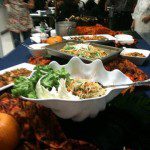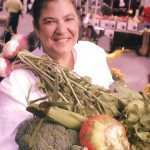My grandparents taught me never to waste food. Raised in the Great Depression and ushered into adulthood through World War II, food shortages and rationings were ingrained somewhere deep within them. As food became more plentiful, their habits of conservation never changed, and by the time I was a pitter-pattering little nuisance, what I most looked forward to when visiting them was the fridge full of leftovers, the well-preserved remains of the previous day’s feasting. I lived for cold slices of roast beef sopped with day-old juices at two in the afternoon, picking with reckless abandon at congealed masses of macaroni and sour pickles shoved lazily into Ziploc bags. Every piece of food in my grandparent’s house tasted better to me the day after we ate it as dinner. As such, my favorite holiday was Thanksgiving, the patron saint of leftover-producing meals.
“At Thanksgiving, we produce many times the amount of food we need,” says Ris Lacoste, chef and local food advocate. “That plentiful feast, brimming with the harvest’s bounty, is meant to provide a continuous meal of endless duration.”
The history of Thanksgiving is complicated and somewhat controversial—and it’s been seared in the old Hollywood light of Quaker Oats pilgrims and happy, unfettered Indians—but its basic roots lie in traditional European and Native American festivals, held after the harvest cycle to give thanks for a good harvest and rejoice as a community after so many difficult months working the land. It is a holiday where we can break our rules of moderation for an evening, overindulge and get swallowed up by the bounty of the season.
“Thanksgiving Dinner is truly my favorite savory meal,” she says. “It’s certainly not the easiest meal to pull off, but it’s an event of pure experience and orchestration. My mother was a pro. And she, before all else, enjoyed the leftovers—and deservedly so. She made the best potpie for late night snacks after dinner, and for lunch the next day she made us all stuffin’ sandwiches, griddled like a grilled cheese, with turkey, her French Canadian pork stuffing and cranberry sauce. There is nothing like it!”
A sandwich is, of course, an obvious and delicious solution to dealing with Turkey Day leftovers, Ris says. “But you’re really sitting on the precipice of endless possibilities. As seasonal foods go, what you see on the table is what grows together in the fields. They were tailor-made for each other. You can recombine them in almost any way and it will be a success.”
As a chef might, Ris has an array of special leftover tricks up her sleeves. Sweet potato-marshmallow or turkey croquettes are recent creations, served with a cranberry “dipping” sauce (i.e. leftover cranberry sauce). “And I bet green bean and onion casserole would make a handy croquette as well,” she says, “bound with some of those leftover mashed potatoes.”
Turkey chow mein is also a household favorite of Ris’. “And then there are turkey tacos with cranberry and lime, jalape?o cream and ancho-orange sweet potatoes. Turkey hash, turkey chili with sweet potato, peas and pearl onions, turkey and bread salad—a great way to deal with leftover bread.”
But all Thanksgiving leftovers begin with turkey stock, she says. “And it’s so simple! Pick the carcass clean, cover it with water in a stockpot and add loosely chopped onions, carrots, celery, thyme, sage, parsley, bay leaf and peppercorns. While you’re doing the dishes, bring the stock to a boil, reduce it to a simmer, skim on occasion and just let it cook until the vegetables are soft and the carcass appears to have rendered all of its flavor into the stock. From there, you can store it in baggies in your freezer and pull it out when you want to make potpie, soup or anything else later on down the road.”
Ris can write a formal recipe as well as any professional epicure, but in situations like this it’s thrilling to just sit back and listen as the inspiration rolls off the tip of her tongue. Once on the topic of leftover meals, she began rattling a stream of culinary concoctions, making them up as she went along, and it was everything my pen could do to keep up. How many teaspoons of rosemary or tablespoons of butter was the last thing on either of our minds.
“And that can sometimes be the joy of cooking,” Ris says. “In the restaurant, I need to have consistency with every dish, making sure that the lamb shank comes out true to the recipe every time. But cooking at home, I can just make something delicious. It might never be made again, but if it’s really good, the memory will exist forever.”
Thanksgiving is the most genuine holiday, Ris believes. “It is the least cluttered by commercialism—it’s all about food, family and thanks. Pausing to say thanks is something we do not do often enough and acknowledging those who haven’t been as fortunate as ourselves is part of that pause.”
For over two decades Ris has worked with DC Central Kitchen, contributing her culinary wisdom to help feed and educate the less fortunate. “Food is what I know,” she says. “It’s what I do, and it’s what I am. I love working with DC Central Kitchen because it allows me to give back in the way I know how—through food and cooking.”
DC Central Kitchen turns donated food, leftover food into millions of meals for thousands of at-risk members of our community, while offering nationally recognized culinary job training to once homeless and at-risk individuals. They recycle 3,000 pounds of food each day, converting individual donations into 4,500 meals that they distribute to around 100 shelters, transitional homes and rehabilitation clinics throughout the District. They also provide counseling services to the chronically homeless, and employ graduates from their culinary program in the kitchen’s full-service catering company, or place them in jobs at restaurants and hotels.
I accompanied Ris on a visit to DC Central Kitchen where local chefs and members of Les Dames d’Escoffier gathered to host cooking classes with the kitchen’s Culinary Job Training program’s 86th class. The students came in to observe and get exposure to new ingredients and techniques from local restaurant chefs, and all were ready to jump in front of the stovetops and give the techniques a try.
Ris and I walked around the kitchen during a downbeat, peaking into the pantries and refrigerators. “During my time off I came here every Thursday,” she said. “I would organize the pantry and make 50 gallons of some protein or salad with the miscellaneous cans and jars donated to the kitchen. We used all of it, these odds and ends—from crackers to canned corn to butterscotch sauce—and turned it into really great quality food. I always felt better when I left than when I arrived.”
The spirit of giving, of making something from nothing, of leftovers, was wafting in the air like firewood on a chilly evening. At the end of the day, a feast was had by all the chefs, students, staff and volunteers of DC Central Kitchen: papaya salad, Irish soda bread, lentil soup with citrus, chicken stir-fry with lo mein noodles and sautéed green beans. It was like an international food fair.
But it ultimately comes back to the kitchen, and the art of cooking without wasting. “Just like your grandparents or my mother,” said Ris, “DC Central Kitchen is making beautiful and nourishing meals without wasting a drop. But this kitchen is more than just leftovers—it’s real cooking. What they are able to accomplish humbles me.”
For Ris, this is the soul of Thanksgiving. “Be thankful for what you have, and for what is at your table,” she says. “And don’t forget to do what you can to give back to your community.”
For more information on DC Central Kitchen and their culinary training program, donating and volunteering opportunities, and catering services, visit DCCentralKitchen.org.
As a Christmas present from Ris, we want to answer your culinary questions for our next column. Questions on cooking techniques, recipes, cookbook recommendations, or epicurean gift ideas? We want to hear! Email your questions to Ari@Georgetowner.com and look for our answers in The Georgetowner’s December 14th issue. Happy Cooking!
- DC Central Kitchen




